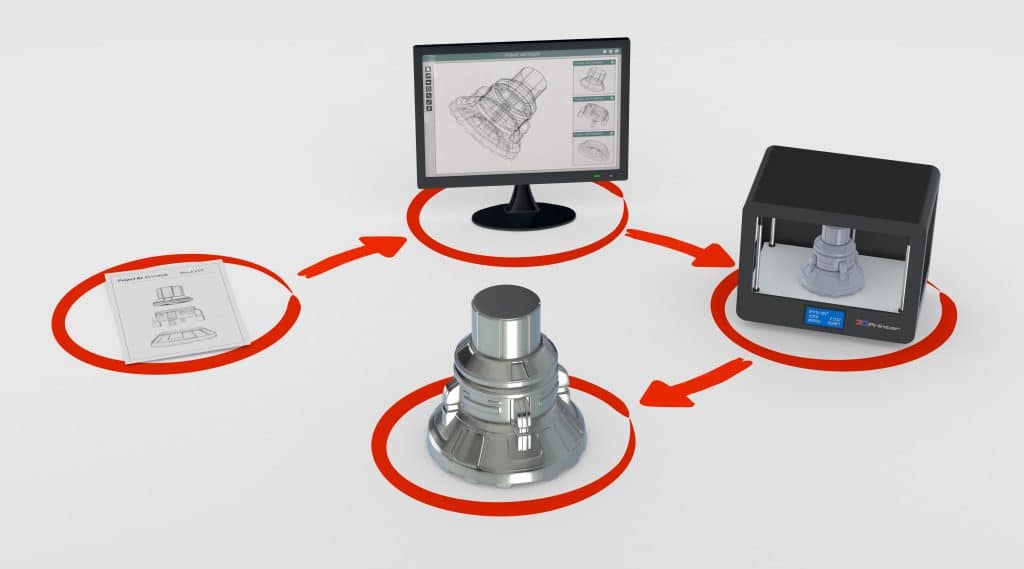Creating and producing a new product can be a long and expensive process. You must take into account many factors and considerations in order to design the perfect product that meets the needs of your audience. Before you jump from your first design to manufacturing the final product, you need to test the product to make sure it fulfills its intended purpose without any issues.
There are a few ways to test a product but the best and most common is prototype testing. Prototype testing allows you to feel and use the product without committing. Beyond just creating a single prototype, though, it’s important to conduct more than one prototype testing to ensure your product is meeting real-world standards.
What is a Prototype?

Launching a product straight from the design stage to full-fledged production can be risky and may cost you more money in the long run. In order to make sure a product is ready for the market, it is important to have it tested both in a laboratory, official setting as well as the real world with end-users. When prototypes are released to be tested, it is called prototype testing.
Prototypes allow that possibility. They are models or early versions of a product that were created to evaluate the features of said product. Prototypes are typically unfinished and focus more on the functions of a product rather than the final design of it. Although they are unfinished, prototypes are meant to look as close to the final product as possible in order to obtain honest and usable feedback from users.
Ultimately, a prototype is meant to help a company assess the new product’’s value, quality, and marketing strategy.
Why You Need to Prototype Testing
While you may be confident in your design of your product, there are numerous reasons to conduct prototype testing that ultimately will deliver you a stronger, better built product. Simply bringing your design from paper to reality can help you view your product from a different perspective allowing you to see if it is still a relevant and needed product.
Reduce cost
Creating and testing a prototype allows you to save money and time; if you go straight from design to launch, you may run into problems with the product that you could have figured out during testing. Even a small printing mistake or design flaw can cost millions of dollars in reproduction as well as many hours spent fixing it.
Test user interaction
Prototypes let your end users interact with the product before you launch it, allowing them to give you feedback on the functionality and design. Although you and your team may think you have a perfect product, users can see outside of your creation bubble to give advice.
Functionality
Many products, such as medical devices, have a set code of requirements they must meet before launching a product. Testing out a prototype allows flaws to be discovered in a safe and controlled environment, rather than on the actual consumers which you could be liable for.
Modify tooling
As you produce your first or second prototype, you may notice that the equipment you are using could be different from the final manufacturing process. Prototypes allow you to adjust the tooling and equipment to make the process more efficient, as well as possibly consolidate any production steps that will help cut down on labor and raw material costs.
Reduce risk
Products that use prototype testing lower their overall risk compared to those who skip prototyping. Prototype testing directly affects how resources are allocated including time and money. With prototyping, you are able to estimate costs and resources more easily.
Usability vs. Prototype Testing
Conducting prototype testing means you are using a method of usability testing. Usability testing as a broader term means to evaluate a product or service by testing it with an audience while prototype testing is specific to the prototype. The testers will find any problems with the product and ask questions about it. The end goal is to gather data about how the users interact with the product or service.
Usability testing can be an important part of prototype testing. It allows researchers to understand if a prototype is meeting the intended purpose of the product and if the users can use the product. There are many methods and stages to testing a prototype; usability testing is just one way of many.
Stages of Prototype Testing

There is more to prototype testing than creating an initial prototype and letting a few people tell you their thoughts about it. Prototype testing, or prototyping, is a process of taking a product from the initial idea to its final marketable form. In order to ensure you aren’t wasting money and time, it’s important to consider a number of factors during prototype testing such as cost, form, and function.
Understanding your product and what you are testing it for will determine the type of prototype testing you will conduct and help you with your long-term design changes. Before beginning to develop your prototype, it’s important to answer questions such as:
- What is the problem the prototype is solving?
- What are your resources and price?
- Are there other options available that will make the prototype unnecessary?
A prototype, and the end-product, should be able to meet the needs and requirements of the intended customer while still being affordable and cost-effective to produce.
Stage 1: Find your target audience
The biggest reason for testing your prototype is to create awareness for the product and test it for design and feature flaws. In order to do this, you need to figure out who your test audience is. Ideally, your prototype tests will be conducted by those who are a part of that audience.
Making sure you are testing within your target audience is especially important if you are testing a new product redesign. If you have people who are already familiar with your product, they will be able to more accurately describe any unwanted changes or issues that appear in the new product.
Stage 2: Create the prototype
There are many different kinds of prototypes and they depend on the intended testing and the type of product you are creating. Below are some of the most common types of prototypes utilized:
Low-fidelity prototypes
Low-fidelity prototypes, or lo-fi, are prototypes designed for rapid production and used to test the functionality of a product rather than the overall design of it. The basic shape of the product is created, but the importance is placed on how it works. Your target audience or design team is able to interact with it and understand the overall concept in a tangible way. Some examples of low-fidelity prototypes include wireframes, paper designs, and low-cost 3D printing designs.
High-fidelity prototypes
Opposite to low-fidelity prototypes are high-fidelity prototypes that are as close to the real product as possible. They are highly interactive and functional, showcasing most of the final components. These prototypes are used to assess user feedback and functionality. Since they feel like the final product, users are more likely to behave with it more naturally.
Live data prototypes
Live data prototypes take high-fidelity prototypes one step further by integrating live user data in the form of different codes on top of an existing product. They are used to gather information about products on the market. As this type of prototype works within data, it is restricted to technology products, such as websites. Websites will make use of an API or other data to place real content into prototypes and can be tracked using a variety of analytical tools.
Feasibility prototype
If you need to test a specific functionality of a product, you would utilize a feasibility prototype that functions within boundaries to test the technology behind a specific function. Feasibility prototypes allow you to understand the technical risk of a new product as well as the overall performance of it.
Stage 4: Choose your usability testing method
Among the methods of prototype testing, the usability prototype is arguably one of the most important ones. It allows users to test how the product functions and if there are any problems that can be solved with a redesign.
There are two main categories of usability testing methods. Your choice will depend on your product and what you are looking for from prototype testing.
Unmoderated vs. moderated testing
Moderated usability testing means that a person will be with the target audience to moderate the prototype testing. This person will work directly with the testers to answer any questions they may have or help with any challenges. Moderated testing often takes place in person, but it can be conducted remotely as well.
Unmoderated ability testing, though, means the tester is alone. They interact with the prototype without guidance at their own pace. Unmoderated testing is best suited for prototypes that need to validate the design and concept of a product, as well as use a large sample size.
Moderated usability, on the other hand, takes more time and can be used for products that have complex interactions and may need some extra guidance or have specific questions answered.
Quantitative vs. qualitative testing
During prototype testing, you are bound to get a lot of data that will help decide the next direction of your product. This data can be divided up into quantitative data and qualitative data.
With qualitative testing, or data, you are gathering information about how your target audience interacts with the prototype. Qualitative testing focuses more on the user’s expectations and emotions, such as finding out how they feel about the product, whether that is negative or positive, and if they had any difficulties using it.
Quantitative testing focuses on the numbers rather than the emotions of users. Typically, you need a large testing pool to have enough information for a qualitative test. The qualitative test will help find trends among the users behavior while interacting with the prototype. These tests can be found in the form of A/B testing, questionnaires, and other data points. Both quantitative testing and qualitative testing are necessary to get a full picture of your prototype.
Stage 5: Evaluate the test results
Once you have conducted your prototype testing and gathered the data needed, it is time to evaluate it. Protopype testing often leads to changes in design and even functionality. Perhaps that button doesn’t need to be there or the user doesn’t like the weight of a new controller.
It’s important to factor in these changes to another prototype as well as the overall cost and effectiveness of the end-product.
What is Rapid Prototyping?
You may have come across the term rapid prototyping in your research and wondered where it fits into prototype testing. Rapid prototyping is a fairly new term and at its core means to create a prototype quickly. It is used most often to test a specific functionality or feature of a product.
Rapid prototypes are usually created using an additive manufacturing process, such as 3D printing, to create the basic form of a prototype or parts of a prototype that is then put together. Low-fidelity prototyping will use rapid prototyping to create the basic function of a prototype so that users may experience and test out the functionality of a product without worrying about extensive design, which helps to save on costs and resources.
Best Practices for Prototype Testing

Prototype testing can be a complex process even with the simplest of products, but it’s important to conduct the testing and conduct it in the right way in order to save money, resources, and time. Proper prototype testing will result in a better end-product.
Be specific about what you are testing
In the beginning stages of prototype testing, you must decide on how the product will solve a problem or fulfill a need as well as who the product is for. During this stage, it’s also good practice to be as specific as possible about what the prototype is going to be testing for and who will be testing it. If you test the overall product at once, you will have too much generalized data and won’t be able to improve the prototype. By specifying exactly what you intend to test, such as a new style of button, you can pinpoint the data that needs to be collected, as well as narrow down your test audience.
Test multiple prototype versions
The whole point of prototype testing is to improve upon the design and functionality of your idea or current product. If you only use one prototype version, you are missing out on potential improvements that would be overlooked had you used multiple prototype versions. By using different versions of a prototype, you are able to gather more useful feedback regarding the functionality and usability of the product, as well as have more insight on how your users behave with your product.
Audience and environment is key
There’s a reason finding your target audience is an important stage in prototyping; without knowing who the product is for, prototype testing to the wrong audience will waste money and other resources. Consider all of the factors that go into audience creation, such as age, gender, culture, and other variables. If you prototype a test to an audience that is too narrow, you might miss out on valuable feedback from a wider range of people. However, by testing a prototype in an audience that will never use it, such as testing a new medical device for physicians on a group of children, the data won’t be useful.
Plan for changes
As you create your prototype testing plan, make sure to include room for changes down the road. Prototype testing can be one of the most expensive and time-consuming parts of developing any product. Users will make suggestions or have difficulties that you won’t think of and while you may think your second or fourth prototype will be the last one, it may not be. Be sure to have a good team that is able to help implement these changes and you have enough resources to perfect your product.
Start Prototype Testing As Soon As Possible
One of the biggest questions you may have is when you should start prototype testing. The answer is as soon as you finish your first design of the product. Beginning prototype testing in the early stages of design will help you to discover any problems that might come up in the design and can push you to make improvements on the functionality.
To ensure that you are testing your prototype correctly, make sure that each test answers what worked and what didn’t, any new ideas, any new questions, and how users interacted with it on a general level.
The most important part of prototype testing is to ensure that your product will perform its intended purpose, whether that’s creating a new water bottle or a new app that will allow users to track their steps. There may be many iterations of a prototype, and there should be, but prototype testing is well worth the effort, money, and time spent in order to create the best product possible.

